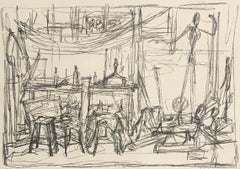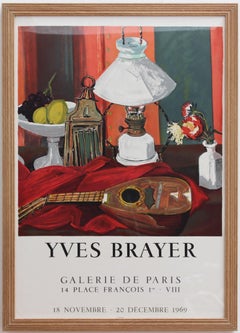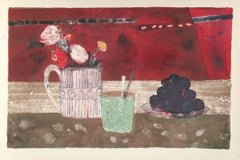Alberto Giacometti Interior Prints
Alberto Giacometti was a painter, printmaker and furniture designer but he is best known as one of the 20th century’s most important sculptors. He is revered for the elongated, slender human figures he created in the years following World War II that reflected existentialism and the trauma associated with the conflict.
Giacometti was born in Borgonovo, Switzerland, in 1901 to a creative family. His father Giovanni was a Post-Impressionist painter, his godfather Cuno Amiet was a Fauvist painter, his brother Bruno was an architect, and his other brother Diego was an artist and furniture designer who also served as Giacometti’s model. (The sculptor worked chiefly with models plucked from his personal life.)
Beginning in 1922, Giacometti studied at the Académie de la Grande-Chaumière in Paris and was influenced by the Cubist work of Alexander Archipenko, Raymond Duchamp-Villon and the post-Cubist sculptures of Jacques Lipchitz and Henri Laurens.
During the 1930s, Giacometti designed furniture such as lamps, vases and wall décor to earn a living, often collaborating with interior designer Jean-Michel Frank, whose interiors tastefully mixed extravagance with sophisticated simplicity. However, Giacometti’s passion lay in creating sculptures.
Alberto and his brother Diego left Paris in 1940 to escape the Nazi invasion and spent time in the South of France before fleeing to Geneva, remaining there until 1946. In 1947, Giacometti began work on his most famous sculptures — very tall and thin figurines that came to be associated with frailty and loneliness.
Giacometti catapulted to fame in the United States following two exhibitions of his sculptures in 1948 and 1950 at the Pierre Matisse Gallery in New York City — Jean-Paul Sartre authored the catalogue essay for the latter. In 1961, Giacometti’s friend, Irish playwright Samuel Beckett, asked him to design the set for a re-staging of his play “Waiting for Godot.” His response took on the form of a single plaster tree.
In 1962, Giacometti won the grand prize for sculpture at the Venice Biennale, and for much of the rest of his career, he created modern paintings, drawings and sculptures of plaster, clay and bronze in his small Paris studio. He died in 1966.
Giacometti’s works continue to enthrall collectors. In 2010, his life-size bronze sculpture L'Homme qui marche (“the man who walks”), which now adorns the 100 Swiss Franc banknote, became one of the most expensive sculptures to be sold at auction.
On 1stDibs, discover a range of vintage Alberto Giacometti wall decorations, prints and sculptures.
1950s Modern Alberto Giacometti Interior Prints
Etching
Mid-20th Century Modern Alberto Giacometti Interior Prints
Lithograph
1950s Alberto Giacometti Interior Prints
Lithograph
1960s Modern Alberto Giacometti Interior Prints
Lithograph
1970s Modern Alberto Giacometti Interior Prints
Lithograph
1990s American Modern Alberto Giacometti Interior Prints
Paper, Ink, Etching
1890s Modern Alberto Giacometti Interior Prints
Etching
Late 19th Century French School Alberto Giacometti Interior Prints
Lithograph
Late 20th Century American Modern Alberto Giacometti Interior Prints
Lithograph
Late 19th Century French School Alberto Giacometti Interior Prints
Lithograph
1840s Realist Alberto Giacometti Interior Prints
Lithograph
1960s Modern Alberto Giacometti Interior Prints
Lithograph
1960s Pop Art Alberto Giacometti Interior Prints
Lithograph
1980s Expressionist Alberto Giacometti Interior Prints
Lithograph
Late 19th Century French School Alberto Giacometti Interior Prints
Lithograph
1960s Realist Alberto Giacometti Interior Prints
Lithograph
Alberto Giacometti interior prints for sale on 1stDibs.
Artists Similar to Alberto Giacometti
- 1stDibs ExpertApril 5, 2022Alberto Giacometti is most famous for his sculptures depicting human figures in an iconic tall, thin style. Influenced by Surrealism and Cubism, his style also sought to invoke a sense of distance in the viewer. On 1stDibs, find an array of beautiful Alberto Giacometti pieces from some of the top sellers around the world.
- 1stDibs ExpertApril 5, 2022Alberto Giacometti made hundreds of sculptures out of a variety of materials. Some of his most frequently used ones were plaster, wood and terracotta, but he is perhaps best known for his bronze sculptures. On 1stDibs, find a collection of Alberto Giacometti art.
- 1stDibs ExpertApril 5, 2022Alberto Giacometti worked with clay or plaster to form and shape his sculptures. Once they were completed, many of them were cast in bronze. He enjoyed experimenting with different styles, materials and approaches. While you’ll find a lot of bronze sculptures, there are other works of art that include plaster, clay and paint in his collections. Shop a selection of Alberto Giacometti pieces from some of the world’s top art dealers on 1stDibs.
- 1stDibs ExpertApril 5, 2022Alberto Giacometti is a Swiss sculptor, painter and printmaker, working mainly in Paris. His work was influenced by the cubism, surrealist and expressionist movements. Shop a selection of Alberto Giacometti pieces from some of the world’s top art dealers on 1stDibs.
- 1stDibs ExpertFebruary 21, 2024In his artwork, Alberto Giacometti tried to capture the energy of his figures as well as his own memories, emotional state and view of the world. He is revered for the elongated, slender human figures he created in the years following World War II that reflected existentialism and the trauma associated with the conflict. The very tall and thin figurines depicted in works like L’Homme au doigt, Standing Woman and The Chariot came to be associated with frailty and loneliness. On 1stDibs, shop an assortment of Alberto Giacometti art.
- 1stDibs ExpertMay 3, 2024For his drawings, Alberto Giacometti typically used pencil and paper as his materials. Less frequently, he drew with ink pens and charcoal. Although he is best known for his sculptures, the Italian artist was a prolific sketcher. In 1963, he published a collection of his drawings in a book called 45 Drawings. Explore a range of Alberto Giacometti art on 1stDibs.


